IOSHA hits ERI with $91,500 fine after investigating an accident that killed two riggers
September 22, 2011 - The Indiana Occupational Health and Safety Administration has sent a debt collection 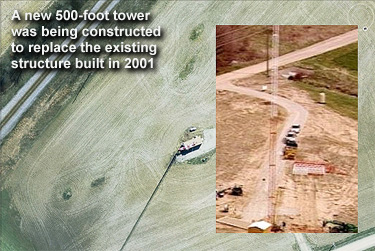 notice with penalties totaling $91,500 to Electronics Research, Inc. of Chandler, Ind. for alleged violations following the death of two tower erectors who fell approximately 320 feet on April 13. notice with penalties totaling $91,500 to Electronics Research, Inc. of Chandler, Ind. for alleged violations following the death of two tower erectors who fell approximately 320 feet on April 13.
Initial accident reports indicated that they were attached to a 90-foot gin pole that was being jumped prior to the crew raising additional sections when a rigging failure caused the pole to come free of the tower.
The Indiana Department of Labor's enforcement agency issued 5 serious safety orders, each with a penalty of $1,500 and 4 knowing orders, with a proposed penalty of $21,000 each.
The current maximum penalty for a serious violation, one capable of causing death or serious physical harm, is $7,000 and the maximum penalty for a willful or knowing violation is $70,000.
Serious citations by IOSHA were:
1. Under a general duty clause (IC 22-8-1.1 Section 2) that requires employers to furnish a place of employment which is free from recognized hazards, that could cause or likely cause death, IOSHA said that ERI did not have a manufacturer's identification plate and/or markings on their gin pole to reference the load chart as identified in TIA-1019, an industry gin pole standard. Fine: $1,500.
2. IOSHA said the company's designated competent person on the site failed to identify existing and predictable hazards or take the necessary measures to alleviate the hazards of falls and gin pole operations. The agency cited a standard (29 CFR 1926.20(b)(2)) that requires inspections for frequent and regular inspection of the job site by a competent person. Fine: $1,500.
3. Citing a requirement (29 CFR 1926.21(b)(2)) that the employer did not instruct each employee in the recognition and avoidance of unsafe conditions and the regulations applicable to his work environment to control or eliminate the hazards, IOSHA called out fall protection and gin pole operations in the safety order. Fine: $1,500.
4. The man-basket involved in the accident was labeled by IOSHA as not being designed by a qualified person familiar with structural design. They said the makeshift device used for hoisting personal should not have been used, citing ERI under 29 CFR 1926.1431(e)(1). Fine: $1,500.
5. The company was again cited for using a man basket for hoisting personnel for not being marked to a reference rated load capacity, a requirement under 29 CFR 1926.1431(e)(12) . Fine: $1,500.
Knowing citations by IOSHA were:
1. Again, under the general duty clause, (IC 22-8-1.1 Section 2), ERI was cited because their employees were exposed to fall hazards while riding the pole connected to the jump line of the gin pole and "not following guidelines published by the National Association of Tower Erectors (NATE industry guidelines for gin pole procedures." IOSHA said a feasible method to correct the hazard is to maintain 100% tie-off, and anchor to the tower. Fine: $21,000.
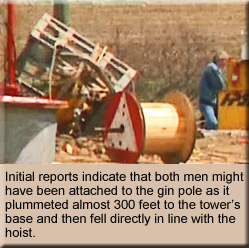 2. Using 29 CFR 1926.95(a) regarding the use of personal fall protection, IOSHA said that ERI's employees installing sections at approximately 320 feet "using gin pole, raising line and accessing the man-basket were not provided with adequate fall protection." Fine $21,000. 2. Using 29 CFR 1926.95(a) regarding the use of personal fall protection, IOSHA said that ERI's employees installing sections at approximately 320 feet "using gin pole, raising line and accessing the man-basket were not provided with adequate fall protection." Fine $21,000.
3. IOSHA said that ERI was in violation of 29 CFR 1926.105(a) which says that safety lines or safety belts should be used, but if they are impractical a safety net shall be provided. They said that employees were not provided fall protection during the gin pole jumping operations and were not 100% tied-off when moving from point to point as well as not having fall protection when they were accessing the man-basket. Fine $21,000.
4. Under 29 CFR 1926.251(a)(4), requiring a gin pole to be marked with the safe working loads and to be proof-tested prior to use to 125% of its rated load, IOSHA said ERI failed to mark its gin pole with the safe working load limits. Fine: $21,000.
Unless ERI contests the penalties they are due by October 5.
The tower site is near the intersection of County Roads 600 North and 900 East near Lafayette.
Although ERI was cited for man basket violations, the equipment was not in use during the time of the accident, but IOSHA noted the violations while they were investigating the fatalities.
ERI was replacing an existing 498-foot tower constructed in 2001 that was located about 1,500 feet from the new structure when the accident occurred.
The tower had to be removed to accommodate the new Hoosier Heartland Corridor.
IOSHA's on site again when construction resumed
Although most federal and state OSHA agencies will return the accident job site back to the contractor and/or owner after an investigation period that runs from days to possibly two weeks, IOSHA did not release the Lafayette tower until more than four months later.
IOSHA was on site on August 17 videotaping the resumption of stacking when a new crew arrived with a new gin pole.
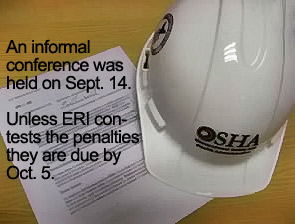 Vice President of Engineering of ERI's structural division, Ernie Jones, has been dedicated to worker safety for many years. He is co-chairman of the subcommittee responsible for developing the TIA/EIA-PN-4860-Gin Pole Standard. Vice President of Engineering of ERI's structural division, Ernie Jones, has been dedicated to worker safety for many years. He is co-chairman of the subcommittee responsible for developing the TIA/EIA-PN-4860-Gin Pole Standard.
He is currently the co-chairman of the TIA\EIA TR14.7 subcommittee responsible for writing the proposed industry construction standard for the installation of antenna towers and antenna supporting structures.
Last ERI violation was eight years ago
Prior to OSHA's recent action, according to the federal agency's database, a complaint had been made against ERI on Aug. 28, 2002 in Illinois. After OSHA investigated a grievance that the company was not in compliance with 1926.21(b)(2), which requires that a company must instruct employees in the recognition and avoidance of unsafe conditions and the regulations applicable to their work environment.
The violation was abated and there was no fine, but another complaint opened on Feb. 27, 2003 saw the agency cite ERI with a serious violation for not providing employees with effective information and training on hazardous chemicals.
The $825 fine for the serious violation was reduced to $400 following an informal settlement. Although they weren't accompanied by fines, four additional citations were issued regarding an emergency action plan, two for respiratory protection, and lockout/tagout for an incident that took place in Indiana.
OSHA again cited ERI in Indiana with three serious violations on May 12, 2003, but the $2,025 fine was reduced down to $506 and only one serious violation was maintained after an informal settlement for a grinding machine infraction. Two other machine violations were issued.
Under OSHA's current aggressive actions against companies, the fine could have been considerably more. In an accident where a grinder was not guarded or set up properly and a worker sustained serious eye and facial injuries, the agency announced September 16 that it has issued $175,000 in proposed penalties to Spincraft of Billerica, Mass.
Highest wireless contractor's fine was $125,000
OSHA offices can levy penalties based upon a company's ability to pay, their previous safety record, and their plan to abate violations and mitigate future occurrences, but final amounts paid by companies are generally lower.
In the 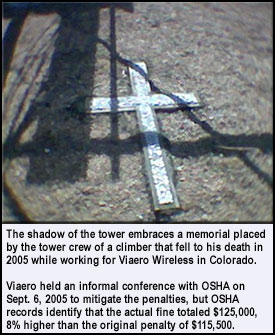 case of Viaero Wireless, the settlement amount was 8% higher with what appears to be the maximum fine issued and paid in the wireless infrastructure industry, $125,000. case of Viaero Wireless, the settlement amount was 8% higher with what appears to be the maximum fine issued and paid in the wireless infrastructure industry, $125,000.
The agency cited NE Colorado Cellular Inc., Fort Morgan, Colo., doing business as Viaero Wireless, for unsafe working conditions, following a fatal accident at a communications tower on Feb. 25, 2005. Proposed penalties issued six months later totaled $115,500.
OSHA alleged one serious and two willful violations of OSHA standards. The willful violations, with proposed penalties of $112,000, involve improper use of a hoist for lifting personnel up the tower, lack of fall protection and failing to remove a defective snap hook from service.
Viaero held an informal conference with OSHA on Sept. 6, 2005 to mitigate the penalties.
They contested OSHA's charges a week later.
In a formal settlement, according to OSHA records, the two willful violations were increased from $56,000 to $60,000, were reduced from willful to serious violations, and placed under the general duty clause which requires that employers shall furnish to each of his employees a place of employment which is free from recognized hazards.
A citation for lack of fall protection training remained, but the penalty was increased from $3,500 to $5,000.
Serious violations have a cap of $7,000, but Denver area director Herb Gibson informed Wireless Estimator today that the $60,000 penalties were allowed by a judge handling a settlement conference.
Corporate fines could be an additional $500,000
Separate from OSHA's enforcement penalties, the Comprehensive Crime Control Act of 1984 allows local prosecutors to bring charges against individuals and they may be fined up to $250,000, or against corporations with a fine up to $500,000 if a willful violation results in an employee's death.
Prison time can accompany those fines. However, the fines and jail time allowable under the Act must stem from a court conviction.
 Charges do not have to be made immediately following an accident and can be made after OSHA announces its findings or even after the case is closed. If any charges were to be issued against ERI it would be handled by Tippecanoe County prosecutor Pat Harrington. Charges do not have to be made immediately following an accident and can be made after OSHA announces its findings or even after the case is closed. If any charges were to be issued against ERI it would be handled by Tippecanoe County prosecutor Pat Harrington.
An attorney, who has represented a number of companies assessed with OSHA violations and fines, told Wireless Estimator that criminal charges could be filed, "but it's not an area where prosecutors are comfortable or knowledgeable about and believe that it should be handled by OSHA."
Previous criminal charges relating to worker deaths have shown that following plea agreements, fines are minimal, if any, and sentencing is typically two years or less and many companies or individuals are put on probation.
After investigating the death of a worker who fell from a roof in 2008, Cal/OSHA fined a company $70,485 but then referred the case to the San Francisco District Attorney.
Workers on the roof didn’t have harnesses or any other type of fall protection, OSHA said.
It took over three years for the case to go to trial and the owner and his crew supervisor pled guilty in May.
The company's owner was charged with involuntary manslaughter, willful violation of a Cal/OSHA order causing death, workers compensation premium fraud and tax evasion. He received a one year prison sentence and must pay restitution.
The supervisor, who was charged with one misdemeanor count of violation of a state labor code, was required to serve at least six months of his one-year sentence.
OSHA's $1.6 million fine reduced by almost 97%
Another fall protection-related criminal case ended in a plea agreement on Aug. 5 following the death of a 17-year-old in a Colorado grain elevator.
OSHA sought almost $1.6 million in fines for 22 willful and 13 serious citations by Tempel Grain after the youth fell into a grain elevator and suffocated.
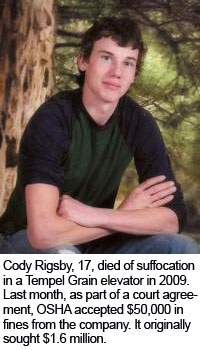 As part of Tempel Grain's agreement with the court, it was required to pay $50,000 in fines and penalties to OSHA as a settlement of administrative fines and penalties assessed against the defendant in the OSHA administrative action - a far cry from OSHA's press release that they were seeking $1.6 million. As part of Tempel Grain's agreement with the court, it was required to pay $50,000 in fines and penalties to OSHA as a settlement of administrative fines and penalties assessed against the defendant in the OSHA administrative action - a far cry from OSHA's press release that they were seeking $1.6 million.
Many of the willful violations were frequently ones associated with those issued to wireless construction companies: not providing an emergency action plan, failing to train workers, no fall protection equipment, a lack of rescue equipment and a lockout/tagout citation.
Tempel Grain was also required to settle civil claims following the accident and provide for the deceased's mother and his four siblings.
Should Tempel Grain violate any of the terms or conditions of their five years of probation they would be potentially liable for additional fines.
Tough news releases end up with weak results
OSHA proudly touts its top enforcement cases on its web site based upon the total issued penalty.
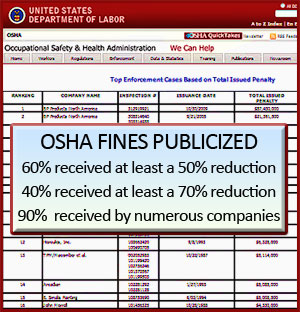 But a closer look reveals that over 60% of the companies received at least a 50% reduction with approximately 40% receiving 70% or more according to press reports, data from the Department of Labor and other published information reviewed by Wireless Estimator. Many reductions were made by administrative law judges. But a closer look reveals that over 60% of the companies received at least a 50% reduction with approximately 40% receiving 70% or more according to press reports, data from the Department of Labor and other published information reviewed by Wireless Estimator. Many reductions were made by administrative law judges.
Numerous companies were able to obtain settlements of 90% of more.
After an explosion on Sept. 8, 1993, Hercules, a N.J. company, was cited for safety and record-keeping violations and fined almost $6.3 million. The amount was later lowered to $100,000, a 98% reduction.
The most publicized reduction of an initial fine amounted to 99% when an administrative law judge reduced $5.09 million levied against Arcadian Corporation to $50,000.
OSHA had fined the fertilizer manufacturer $50,000 for each of the 87 employees the company had put in danger by not fixing a leak that led to an explosion. But the judge determined that the agency could only fine the company for one violation in connection with the explosion that injured seven workers in 1993.
Tower infrastructure industry fines lower than national average
Current penalties against employers that endanger workers’ health and safety are too low to deter future violations, witnesses informed the House Education and Labor Committee in 2009.
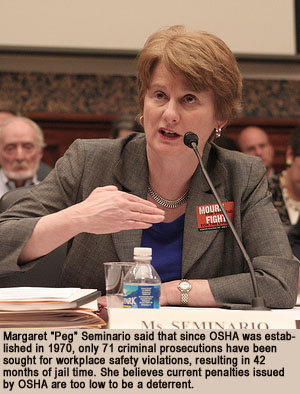 Margaret "Peg" Seminario, director of safety and health at the AFL-CIO said, “Our analysis found that the average penalty for a serious violation is less than $1,000 and the average penalty involving workers deaths is $11,300.” Margaret "Peg" Seminario, director of safety and health at the AFL-CIO said, “Our analysis found that the average penalty for a serious violation is less than $1,000 and the average penalty involving workers deaths is $11,300.”
The average penalty during 2008 and 2009 relating to workers deaths in the tower construction and maintenance industry was 46% less at $6,100. The average penalty for a serious violation when there was a climber fatality during the same period was $1,556.
However, when there was no fatality, serious violations averaged $687 for 18 companies cited. Duty to have fall protection was a frequent violation, oftentimes being set at $400, according to OSHA reports reviewed by Wireless Estimator.
Seminario said in 2009 that since OSHA was established in 1970, only 71 criminal prosectuions have been sought for workplace safety violations, resulting in 42 months of jail time.
Except for the owner of a trucking company in Pennsylvania who was sentenced to 11 to 23 months in jail for his gross negligence in 2010, which resulted in a major trucking accident that resulted in the death of a 49-year old husband and father of three, there have been no published criminal prosecutions that have resulted in a prison sentence since Seminario voiced her concerns.
|